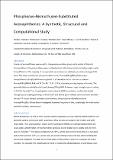Files in this item
Phosphorus‒bismuth peri-substituted acenaphthenes : a synthetic, structural and computational study
Item metadata
| dc.contributor.author | Nejman, Phillip | |
| dc.contributor.author | Curzon, Thomasine Emily | |
| dc.contributor.author | Buehl, Michael | |
| dc.contributor.author | McKay, David | |
| dc.contributor.author | Woollins, J Derek | |
| dc.contributor.author | Ashbrook, Sharon E. | |
| dc.contributor.author | Cordes, David Bradford | |
| dc.contributor.author | Slawin, Alexandra Martha Zoya | |
| dc.contributor.author | Kilian, Petr | |
| dc.date.accessioned | 2021-04-08T23:49:58Z | |
| dc.date.available | 2021-04-08T23:49:58Z | |
| dc.date.issued | 2020-04-09 | |
| dc.identifier | 267188305 | |
| dc.identifier | d73c2df2-caca-4add-b607-ad2cca372e7a | |
| dc.identifier | 85083305568 | |
| dc.identifier | 000526885800043 | |
| dc.identifier.citation | Nejman , P , Curzon , T E , Buehl , M , McKay , D , Woollins , J D , Ashbrook , S E , Cordes , D B , Slawin , A M Z & Kilian , P 2020 , ' Phosphorus‒bismuth peri -substituted acenaphthenes : a synthetic, structural and computational study ' , Inorganic Chemistry , vol. Article ASAP . https://doi.org/10.1021/acs.inorgchem.0c00317 | en |
| dc.identifier.issn | 0020-1669 | |
| dc.identifier.other | ORCID: /0000-0002-1095-7143/work/71954858 | |
| dc.identifier.other | ORCID: /0000-0001-6379-3026/work/71954864 | |
| dc.identifier.other | ORCID: /0000-0002-9527-6418/work/71954867 | |
| dc.identifier.other | ORCID: /0000-0002-1498-9652/work/71954934 | |
| dc.identifier.other | ORCID: /0000-0002-5366-9168/work/71954938 | |
| dc.identifier.other | ORCID: /0000-0002-4538-6782/work/71954982 | |
| dc.identifier.other | ORCID: /0000-0003-0362-7848/work/71955514 | |
| dc.identifier.uri | https://hdl.handle.net/10023/22991 | |
| dc.description | This work was financially supported by the Engineering and Physical Sciences Research Council (EPSRC). This included PhD studentship to TEC (Centre for Doctoral Training in Critical Resource Catalysis (CRITICAT), Grant code: EP/L016419/1) and to PN (Grant code EP/L505079/1). The authors would like to thank COST action SM1302 SIPs; the EPSRC UK National Mass Spectrometry Facility at Swansea University for the acquisition and processing of Mass Spectrometry Data and to EaStCHEM and the School of Chemistry for support. | en |
| dc.description.abstract | A series of acenaphthene species with a diisopropylphosphino group and a variety of bismuth functionalities in the peri-positions were synthesised and fully characterised, including single crystal X–ray diffraction. The majority of the reported species feature a relatively rare interpnictogen P−Bi bond. The series includes the phosphine¬−bismuthine, Acenap(PiPr2)(BiPh2) 2 (Acenap = acenaphthene-5,6-diyl), which was subjected to a fluorodearylation reaction to produce Acenap(PiPr2)(BiPhX) 5−8 and 10 (X = BF4-, Cl, Br, I, SPh), displaying varying degrees of ionicity. The geminally bis(acenaphthyl) substituted [Acenap(PiPr2)2]BiPh 3 shows a large through-space coupling of 17.8 Hz, formally 8TSJPP. Coupling deformation density (CDD) calculations confirm the double through-space coupling pathway, in which the P and Bi lone pairs mediate communication between the two 31P nuclei. Several synthetic routes towards the phosphine−diiodobismuthine Acenap(PiPr2)(BiI2) 9 have been investigated, however the purity of this, surprisingly thermally stable potential synthon, remains poor. | |
| dc.format.extent | 1074972 | |
| dc.format.extent | 941773 | |
| dc.language.iso | eng | |
| dc.relation.ispartof | Inorganic Chemistry | en |
| dc.subject | QD Chemistry | en |
| dc.subject | DAS | en |
| dc.subject.lcc | QD | en |
| dc.title | Phosphorus‒bismuth peri-substituted acenaphthenes : a synthetic, structural and computational study | en |
| dc.type | Journal article | en |
| dc.contributor.sponsor | EPSRC | en |
| dc.contributor.institution | University of St Andrews. EaSTCHEM | en |
| dc.contributor.institution | University of St Andrews. School of Chemistry | en |
| dc.identifier.doi | https://doi.org/10.1021/acs.inorgchem.0c00317 | |
| dc.description.status | Peer reviewed | en |
| dc.date.embargoedUntil | 2021-04-09 | |
| dc.identifier.grantnumber | EP/L016419/1 | en |
This item appears in the following Collection(s)
Items in the St Andrews Research Repository are protected by copyright, with all rights reserved, unless otherwise indicated.


